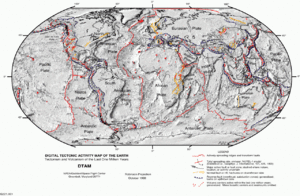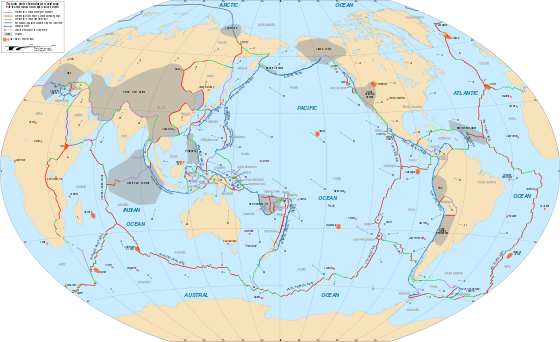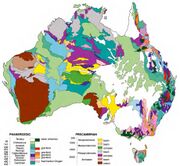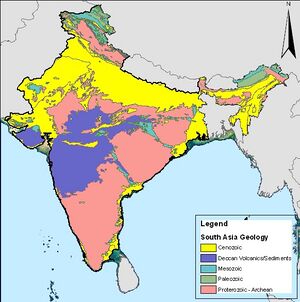قائمة الصفائح التكتونية
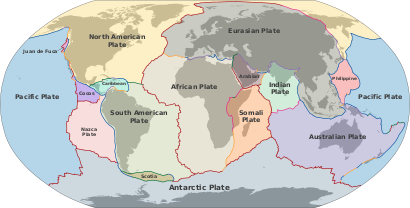
Divergent:
This is a list of tectonic plates on Earth's surface. Tectonic plates are pieces of Earth's crust and uppermost mantle, together referred to as the lithosphere. The plates are around 100 km (62 mi) thick and consist of two principal types of material: oceanic crust (also called sima from silicon and magnesium) and continental crust (sial from silicon and aluminium). The composition of the two types of crust differs markedly, with mafic basaltic rocks dominating oceanic crust, while continental crust consists principally of lower-density felsic granitic rocks.
Current plates
Geologists generally agree that the following tectonic plates currently exist on Earth's surface with roughly definable boundaries. Tectonic plates are sometimes subdivided into three fairly arbitrary categories: major (or primary) plates, minor (or secondary) plates, and microplates (or tertiary plates).[1]
Major plates
These plates comprise the bulk of the continents and the Pacific Ocean. For purposes of this list, a major plate is any plate with an area greater than 20 million km2.
- African Plate – 61,300,000 km2
- Antarctic Plate – 60,900,000 km2
- Eurasian Plate – 67,800,000 km2
- Indo-Australian Plate (sometimes considered to be two separate tectonic plates) – 58,900,000 km2
- Australian Plate – 47,000,000 km2
- Indian Plate – 11,900,000 km2
- North American Plate – 75,900,000 km2
- Pacific Plate – 103,300,000 km2
- South American Plate – 43,600,000 km2
Minor plates
These smaller plates are often not shown on major plate maps, as the majority of them do not comprise significant land area. For purposes of this list, a minor plate is any plate with an area less than 20 million km2 but greater than 1 million km2.
- Amurian Plate
- Arabian Plate – 5,000,000 km2
- Burma Plate – 1,100,000 km2
- Caribbean Plate – 3,300,000 km2
- Caroline Plate – 1,700,000 km2
- Cocos Plate – 2,900,000 km2
- Indian Plate – 11,900,000 km2
- Nazca Plate – 15,600,000 km2[note 1]
- New Hebrides Plate – 1,100,000 km2
- Okhotsk Plate
- Philippine Sea Plate – 5,500,000 km2
- Scotia Plate – 1,600,000 km2
- Somali Plate – 16,700,000 km2
- Sunda Plate
- Yangtze Plate
Microplates
These plates are often grouped with an adjacent principal plate on a tectonic plate world map. For purposes of this list, a microplate is any plate with an area less than 1 million km2. Some models identify more minor plates within current orogens (events that lead to a large structural deformation of Earth's lithosphere) like the Apulian, Explorer, Gorda, and Philippine Mobile Belt plates.[2] The latest studies have shown that microplates are the basic elements of which the crust is composed and that the larger plates are composed of amalgamations of these, and a subdivision of ca. 1200 smaller plates has come forward.[3][4]
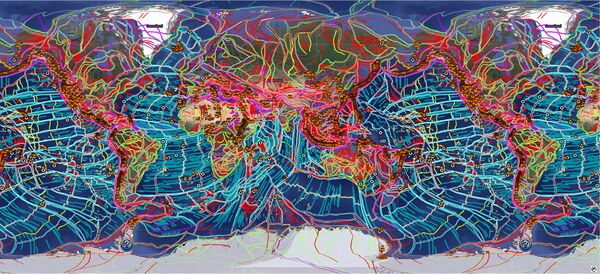
- African Plate
- Antarctic Plate
- Australian Plate
- Caribbean Plate
- Cocos Plate
- Eurasian Plate
- Adriatic Plate, also known as the Apulian Plate
- Aegean Sea Plate, also known as Hellenic Plate
- Anatolian Plate
- Azores Microplate[7][8]
- Banda Sea Plate
- Hreppar Microplate – Small tectonic plate in south Iceland, between the Eurasian Plate and the North American Plate
- Iberian Plate
- Iranian Plate
- Molucca Sea Plate
- Okinawa Plate
- Pelso Plate
- Timor Plate
- Tisza Plate
- Juan de Fuca Plate – 250,000 km2
- Nazca Plate
- North American Plate
- Pacific Plate
- Philippine Sea Plate
- Mariana Plate
- Philippine Mobile Belt, also known as Philippine Microplate
- Scotia Plate
- Somali Plate
- South American Plate
- Altiplano Plate
- Falklands Microplate
- North Andes Plate (mainly in Colombia, minor parts in Ecuador and Venezuela)
Ancient tectonic plates
In the history of Earth, many tectonic plates have come into existence and have over the intervening years either accreted onto other plates to form larger plates, rifted into smaller plates, or have been crushed by or subducted under other plates.
The following is a list of ancient cratons, microplates, plates, and terranes which no longer exist as separate plates. Cratons are the oldest and most stable parts of the continental lithosphere, and shields are exposed parts of them. Terranes are fragments of crustal material formed on one tectonic plate and accreted to crust lying on another plate, which may or may not have originated as independent microplates: a terrane may not contain the full thickness of the lithosphere.
African Plate
- Atlantica
- Bangweulu Block (Zambia)
- Congo Craton (Angola, Cameroon, Central African Republic, Democratic Republic of Congo, Gabon, Sudan, and Zambia)
- Kaapvaal Craton (South Africa)
- Kalahari Craton (South Africa)
- Saharan Metacraton (Algeria)
- Sebakwe proto-Craton (Zimbabwe)
- Tanzania Craton (Tanzania)
- West African Craton (Algeria, Benin, Burkina Faso, Côte d'Ivoire, Gambia, Ghana, Guinea, Guinea Bissau, Liberia, Mali, Mauritania, Morocco, Nigeria, Senegal, Sierra Leone, and Togo)
- Zaire Craton (Congo)
- Zimbabwe Craton (Zimbabwe)
Antarctic Plate
- Bellingshausen Plate
- Charcot Plate
- East Antarctic Shield, also known as East Antarctic Craton
- Phoenix Plate
Eurasian Plate
- Armorica (France, Germany, Spain and Portugal)
- Avalonia (Canada, Great Britain, and United States)
- Baltic Plate
- Belomorian Craton
- Central Iberian Plate
- Cimmerian Plate (Anatolia, Iran, Afghanistan, Tibet, Indochina and Malaya)
- East China Craton[بحاجة لمصدر]
- East European Craton
- Baltic Shield, also known as Fennoscandian Shield
- Junggar Plate and Eastern Kazakhstan
- Hunic plate
- Karelian Craton
- Kazakhstania and the Junngar Basin in China
- Kola Craton
- Lhasa terrane
- Massif Central
- Moldanubian Plate
- Moravo Silesian Plate
- Midlands Microcraton
- North Atlantic Craton
- North China Craton
- Ossa-Morena Plate
- Piemont-Liguria Plate
- Proto-Alps Terrane
- Rhenohercynian Plate
- Sarmatian Craton
- Saxothuringian Plate
- Siberian Craton
- South Portuguese Plate
- Tarim Craton
- Teplá-Barrandian Terrane
- Ukrainian Shield
- Valais Plate
- Volgo-Uralian Craton
- Yakutai Craton
- Yangtze Craton
Indo-Australian Plate
- Altjawarra Craton (Australia)
- Aravalli Craton (India)
- Bastar Craton (India)
- Bhandara Craton (India)
- Bundelkhand Craton (India)
- Dharwar Craton
- Central Craton (Australia)
- Curnamona Craton (Australia)
- Gawler Craton
- Indian Craton
- Narooma Terrane
- Pilbara Craton
- Singhbhum Craton (India)
- Yilgarn Craton
- Australian Shield, also known as Western Australian Shield
- Zealandia. See Moa Plate and Lord Howe Rise
North American Plate
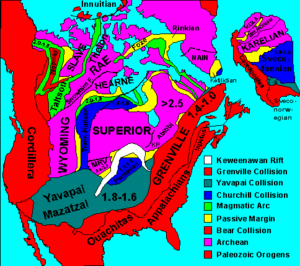
- Avalonia (Canada, Great Britain, and United States)
- Carolina Plate
- Churchill Craton (Canada)
- Farallon Plate (split into the Cocos, Explorer, Juan de Fuca, Gorda Plates, Nazca Plate, and Rivera Plates)
- Florida Plate (United States)
- Hearne Craton (Canada)
- Laurentian Craton, also known as North American Craton (Canada and United States)
- Insular Plate
- Intermontane Plate
- Izanagi Plate
- Mexican Plate
- Nain Province (Canada)
- Newfoundland Plate
- North Atlantic Craton
- Nova Scotia Plate
- Rae Craton (Canada)
- Sask Craton (Canada)
- Sclavia Craton (Canada)
- Slave Craton (Canada)
- Superior Craton (Canada)
- Wyoming Craton (United States)
South American Plate
- Amazonian Craton (Brazil)
- Guiana Shield (Brazil, Colombia, French Guiana, Guyana, Suriname and Venezuela)
- Río de la Plata Craton (Argentina and Uruguay)
- São Francisco Craton (Brazil)
- Arequipa–Antofalla Craton (Argentina, Bolivia, Chile and Peru)
See also
- Asthenosphere
- Continent
- Craton
- Earth's crust
- Earth's mantle
- Geochemistry
- Hydrosphere
- Lithosphere
- Ocean
- Plate tectonics
- List of tectonic plate interactions – Types of plate boundaries
- Supercontinent
- Terrane
Notes and references
Notes
References
- ^ Madaan, About Sonia (2020-08-18). "7 Major Tectonic Plates (Pacific, African, Eurasian, Antarctic and more)". Earth Eclipse. How Many Tectonic Plates Are on Earth?. Retrieved 2022-05-12.
- ^ Bird, P. (2003). "An updated digital model of plate boundaries". Geochemistry, Geophysics, Geosystems 4 (3): 1027. DOI:10.1029/2001GC000252. http://peterbird.name/publications/2003_PB2002/2003_PB2002.htm.
- ^ Hasterok, D., Halpin, J., Collins, A.S., Hand, M., Kreemer, C., Gard, M., and Glorie, S. (2022); New maps of global geological provinces and tectonic plates. Earth Science Reviews, 2022.
- ^ van Dijk, J.P. (2023); The New Global Tectonic Map - Analyses and Implications. Terra Nova, 2023, 27 pp. DOI:10.1111/TER.12662
- ^ Antarctic Plate Tectonics
- ^ Gasperini, L; Ligi, M; Accettella, D; Bosman, A; Cuffaro, M; Lodolo, E; Martorelli, E; Muccini, F; Palmiotto, C; Polonia, A (1 February 2023). "Late Miocene to recent tectonic evolution of the Macquarie Triple Junction". Geology. 51 (2): 146–50. doi:10.1130/G50556.1.
- ^ "Introduction - Project Cratera". utl.pt.
- ^ Demets, C., Gordon, Richard, & Argus, Donald, «MORVEL: A new estimate for geologically recent plate motions» in AGU Fall Meeting Abstracts.
- ^ Niels Henriksen; A.K. Higgins; Feiko Kalsbeek; T. Christopher R. Pulvertaft (2000). "Greenland from Archaean to Quaternary" (PDF). Greenland Survey Bulletin. No. 185. Archived from the original (PDF) on 2008-12-07. Retrieved 2009-10-04.
ببليوجرافيا
- North Andes Plate
- Restrepo, Jorge Julián; Ordóñez Carmona, Oswaldo; Martens, Uwe; Correa, Ana María (2009). "Terrenos, complejos y provincias en la Cordillera Central de Colombia (Terrains, complexes and provinces in the central cordillera of Colombia)". Ingeniería Investigación y Desarrollo. 9: 49–56. Retrieved 2019-10-31.
- Fuck, Reinhardt A.; Brito Neves, Benjamim Bley; Schobbenhaus, Carlos (2008). "Rodinia descendants in South America". Precambrian Research. 160: 108–126. Retrieved 2019-10-29.
- Cordani, U.G. (2003). "Geochronology of Proterozoic basement from the Colombian Andes: Tectonic history of remnants from a fragmented Grenville Belt".: 1–10, 10o Congreso Geológico Chileno.
- Restrepo, Jorge Julian; Toussaint, Jean F. (1988). "Terranes and continental accretion in the Colombian Andes". Episodes. 11: 189–193. Retrieved 2019-10-31.
External links
- Bird, Peter (2003) An updated digital model of plate boundaries also available as a large (13 Mb) PDF file
